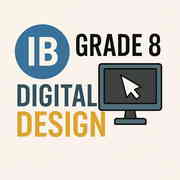Professional Courses
Industry-relevant training in Business, Technology, and Design
Categories
Interactive Games
Fun games to boost memory, math, typing, and English skills
Typing
Memory
Math
English Adventures
Knowledge

IB 8 Design (Digital Design)
The Grade 8 Digital Design course engages students in the IB MYP Design Cycle through hands‑on, project‑based learning. Students will develop creative solutions to real‑world problems by applying design thinking, digital literacy, and technical skills. Throughout the four stages—inquiry, concept development, prototyping, and evaluation—learners will master industry‑standard software and reflect on the social and ethical impact of digital media. By the end of the course, students will produce a polished digital artifact (graphic, animation, or interactive media) and articulate their process in a comprehensive design portfolio.
Course Chapters
Unit 1: Inquiring and Analysing (Criterion A)
Students learn to navigate the complexities of interpreting design briefs, structuring problems, and validating research integrity. The chapter emphasizes transforming data into actionable insights while collaborating with stakeholders to create adaptable specifications. It empowers learners with critical analytical tools and effective research methods that inform design decisions and allow for innovative problem-solving.
Unit 2: Developing Ideas (Criterion B)
The chapter emphasizes the complete process of developing ideas, guiding students from gathering requirements to conceptual validation. It covers essential methodologies including ideation techniques, sketching conventions, and digital wireframing, providing detailed protocols and tools at each stage. By engaging in various structured activities and exercises, students create a professional portfolio that reflects their understanding and application of these concepts.
Unit 3: Creating the Solution (Criterion C)
The chapter details the process of transforming wireframes into functional digital prototypes using current design software. It covers essential principles of visual design, layering techniques, and the incorporation of motion design elements. Iterative feedback is emphasized to refine designs for more effective user experience.
Unit 4: Evaluating (Criterion D)
Evaluation serves as a critical phase in the design cycle that assesses the effectiveness, efficiency, and user satisfaction of a product against its original specifications. The chapter outlines detailed methodologies for developing usability test plans, conducting structured sessions, gathering feedback, and analyzing data to formulate actionable recommendations. Additionally, it emphasizes the importance of reflective writing and compiling comprehensive evaluation reports for ongoing improvement in design practices.
